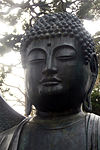| Part of a series on |
| Western Buddhism |
|---|
 |
Buddhism in Hungary has existed since 1951 when Ernő Hetényi founded the Buddhist Mission in Germany, as a member of the Arya Maitreya Mandala Buddhist order (Mahayana school). However, the first Buddhist community had been founded in the 1890s in Máramarossziget (today Sighetu Marmației, part of Romania). József Hollósy took refuge and wrote Buddhista Kátét ("Buddhist Catechism") (1893) — the first Buddhist catechism in Hungarian. According to this, the Dharma has been present in Hungary for more than a century. In 1933 the Hungarian philologist and Orientalist — author of the first Tibetan-English dictionary and grammar book Sándor Kőrösi Csoma — was recognised as a bodhisattva in Japan. In Hungary József Hollósy is regarded as the second bodhisattva.[1]
In Hungary Buddhism has several forms, all of them with their own independent schools of thought. The different organisations coexist fairly harmoniously, but active communication between them is rather feeble.[2]
Officially seven stupas have been inaugurated in Hungary: two in Budapest, and one in Budakeszi, Bükkmogyorósd (Csernely), Zalaszántó, Tar, and Becskén. The Peace Stupa in Zalaszántó is the biggest Buddhist shrine in Europe with a 30-meter height and 24-meter width.[3]
Hungary has a Buddhist college named Dharma Gate Buddhist College in Budapest.[4]
- ^ "www.tkbe.hu – Hollósy József". Archived from the original on 31 March 2016. Retrieved 18 October 2016.
- ^ "www.terebess.hu – Kárpáty Ágnes: Buddhizmus Magyarországon". Archived from the original on 4 March 2016. Retrieved 18 October 2016.
- ^ "Buddhista sztúpa | Turisztikai információs központ". turizmus.zalatermalvolgye.hu. Archived from the original on 13 March 2016. Retrieved 18 October 2016.
- ^ "welcome". A Tan Kapuja Buddhista Főiskola. Archived from the original on 8 December 2022. Retrieved 15 January 2023.